Giant aircraft K-7
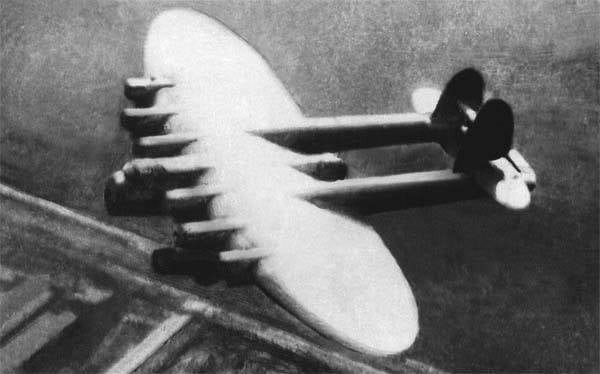
However, the production of the machine was abandoned, and subsequently the K-7 index was assigned to the transcontinental aircraft, which they began to design in the 1928 year. “The idea to design the K-7 aircraft,” KA Kalinin later wrote, “was born a long time ago, back in the 1925 year. In 1929, I formulated my project, which, after two years of refinement, began to be implemented ... When creating new large cars, new ways lead to the new schemes of the airplanes, to the use of the wing for cargo placement. This means that the paths go to the flying wing, which is the perfect plane. To make the transition to the flying wing, it became necessary to build a car on the principle of "everything in the wing."
Originally designed all-wood plane with a five-spar wing. But nothing worked out of this - there was not enough safety margin, so after long disputes Kalinin decided to switch to an all-metal welded structure with a three-spar wing.
K-7 was a giant elliptical wing of a thick profile with a span of 53 m and an area of 452 м2, from which two tail beams of trihedral cross section were carried, carrying tail horizontal and vertical tail elements with a mechanism for turning. The wing had a straightened center section with a width of 6 m, a length of 10,6 m and a height of 2,33 m, where the premises for people and cargo were located. Elliptical consoles in plan were docked to the center section, in which the designers placed 14 fuel tanks. The center section was sheathed in duralumin, the console - in linen. Calculations assumed the installation in the wing of the three side members. But there were no such powerful pipes for the belt of the side members; therefore, the shelves of the middle spar were made of two parallelly arranged and fastened welded kerchief pipes. Wing ribs - steel, from pipes with racks and braces.
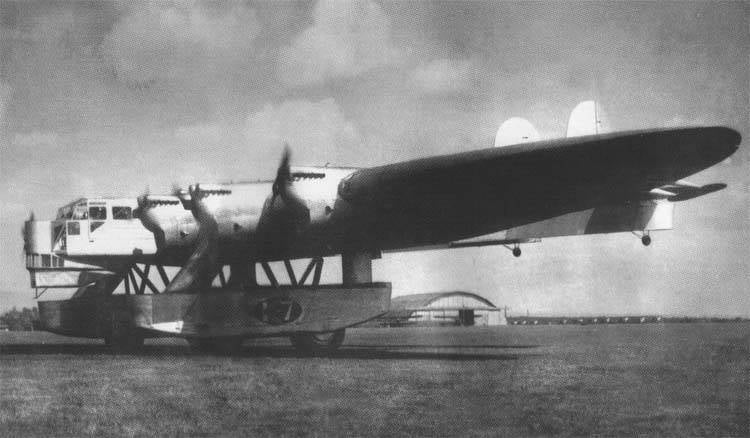
Along the axis of the aircraft, the wheelhouse came forward, where two pilots, a navigator, a radio operator and a senior mechanic were stationed. The remaining seven crew members were in other compartments of the aircraft and talked to each other by internal telephone.
Initially, the aircraft was calculated under the six BMW engines, but then it was decided to install domestic AM-34. In the course of work, due to the low thrust of the six main water-cooled engines, Kalinin went for an enforced measure: he had to install the seventh pushing engine on the rear edge of the wing between the tail booms. The designer understood that this engine would significantly increase the turbulence of the air flow, which, in turn, could cause vibration of the whole structure. But he had no other way out. After all, the AM-34 engines at that time did not yet have gears and only developed the power of the 750 l. with.
From the rear side member of the wing to the tail there were triangular truss-type beams with ducts that protected the plane from accidental contact with the ground.
The original chassis design allowed the aircraft to have a horizontal parking position. The chassis consisted of two widely spaced truss carriages with oil-air wheel damping, first used in domestic practice for heavy vehicles. Also for the first time on the aircraft of this class used the wheels of the balloon type "Goodyear". Our industry did not manufacture such wheels, and in the future it was necessary to make them special.
The chassis carts had three wheels and were equipped with a winding - “trousers” made of sheet metal, with the front door and the stairs to the wing located in the left one.
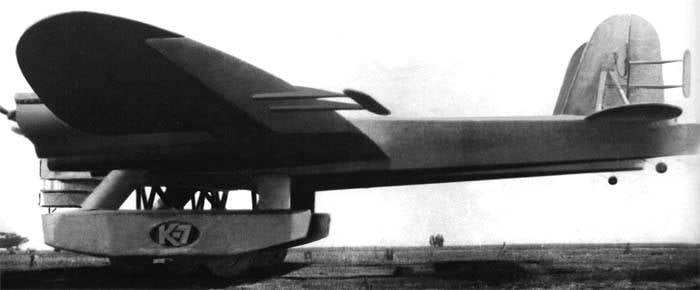
Even during the K-7 design period, it became clear that it would be difficult for a pilot to control such a large aircraft because of the occurrence of enormous forces acting on the rudders. Initially, in order to reduce the load in the aircraft control system, K. A. Kalinin proposed a very promising solution, which later found the widest application in aviation — to install electric boosters on the aircraft. An agreement was concluded with a Moscow Electrotechnical Institute, which undertook to manufacture a new system. But the developers failed to do this task, and therefore they had to supply the K-7 aileron control wheels with servo-wheels, placed on light beams.
Theoretical work on the control of heavy aircraft with the help of servo steering was decided by a group of aerodynamics headed by NF Freiman. More than 300 purging was performed in the TsAGI wind tunnel, and in 1932, the servoes were tested in the air on a K-5 aircraft converted to a flying laboratory. They acted flawlessly, and they were recommended for installation on K-7.
A bold decision of Kalinin can be considered as the use of chrome-molybdenum pipes used for the first time in our country. The calculations for the framework were led by Professor A. S. Balinsky, a prominent scientist in the field of materials resistance. But still the plane turned out to be overweight in the project, since the calculations had to be carried out not on the hardened parts, but on the burned ones after welding, which naturally increased the weight of the airframe.
Simultaneously with the design of the aircraft, the production of seamless chrome-molybdenum steel pipes at the Dnepropetrovsk Lenin Metallurgical Plant was also established. Previously, similar tubes were purchased in Sweden, and only for one K-7 they would have to be purchased for 100 thousand rubles in gold! As noted by the TsAGI Commission in 1932, the K-7 aircraft is already a major step forward in aircraft construction because "by its appearance it permits the introduction of chromomolybdenum pipes in the USSR".
K-7 was designed as a multi-purpose aircraft of civil and military use. One of the passenger options was to transport 128 passengers over a distance of 5000 km. Another option - “luxury” - was to install in the wing two-tier passenger cabins for 8 people in each - the whole 64 bed. In the car there was a comfortable saloon, buffet, kitchen and radio room. For the first time, the design allowed the aircraft mechanics to approach the running engine directly in flight, and passengers to inspect the “flying” terrain in the windows-windows.
A team of armaments, headed by DI Grigorov, invested a lot of effort and labor in the work on K-7. The military version of the aircraft was a real "flying fortress", which appeared nine years earlier than the American "Boeing" B-17. The defensive armament of the Kalinin giant was supposed to be brought to the 12 firing nests (8 guns of the 20 caliber mm and 8 machine guns of the 7,62 caliber mm). For the delivery of shooters to two tail machine guns, a special electric cart was also constructed, moving along the cables inside the tail boom. In terms of defense, the plane had practically no “dead zones”, and at least three points were swept through any point, which increased the reliability of its protection.
Bomber equipment was housed in the wing, and to lighten the weight, the bomb racks were incorporated into the wing support structure. The stock of bombs ranged depending on the flight range from 9,9 t to 16,6 t. The use of outboard tanks guaranteed a range in 2400 km with a bomb load of 6 t.
The landing version of the aircraft was designed for 112 paratroopers. The possibilities of transportation between the chassis trolley were considered. tank weighing 8,4 tons or other parachute dumped equipment.
The technical design of the aircraft was completed at the beginning of 1932. In the courtyard of the Kharkov Aviation Plant, a wooden model of the center part of the future car was built in full size. Since the size of the aircraft did not allow its installation in the existing workshops, a new assembly shop was laid. In November, 1932 of the year started building a prototype machine there, completing it in record time - in just nine months.
In early August, 1933, the aircraft was taken to the runway of the airfield. M. A. Snegireva was appointed his test pilot, A. N. Gratsiansky as a backup. When all engines were first started, the vibration of various parts of the aircraft was detected; the latter had to be strengthened. After that, 19 in August M. A. Snegirev made a K-7 approach in a straight line at an altitude of 5 meters within a few seconds. The approach revealed new troubles - the aircraft’s steering wheels began to vibrate with a large amplitude (up to one meter). In a few days, the tail of the machine was changed - it became biplane, the keels were connected with an additional horizontal surface - the “zener diode”. Servoruli with vertical tail removed, and on the horizontal set them close to the steering wheels.
On the eve of the first flight, the head of the Main Aviation Industry Directorate, P. I. Baranov, flew to Kharkov, accompanied by test pilot M. M. Gromov. By six o'clock in the morning 21 August 1933, the K-7 stood at the start with the engines running. It was a good summer weather, although the clouds covered the airfield with a light haze. The crew of seven people took their seats. And, as always, at the last moment Kalinin himself sat in the co-pilot's seat.
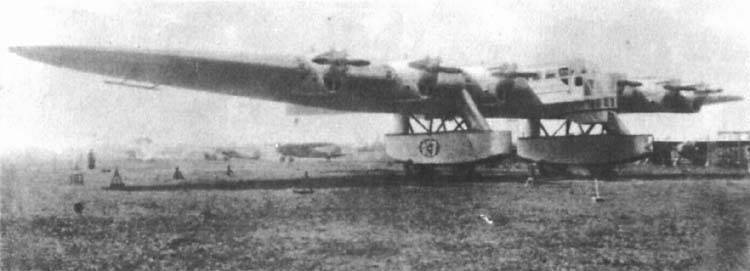
Having previously made several runs, the plane smoothly lifted off the ground. As M. A. Snegirev later said, “the car in the air was well obedient to the rudders. It was easy to manage. I could not even believe it. Slightly pull the steering wheel - and the car immediately answers! "
K-7, having made a circle over Kharkov, gently landed at 14 minutes at the factory airfield. After the report of the pilot P. I. Baranov, M. A. Snegirev was thanked, and K. A. Kalinin was given a symbolic reprimand for an unauthorized departure on an experimental car.
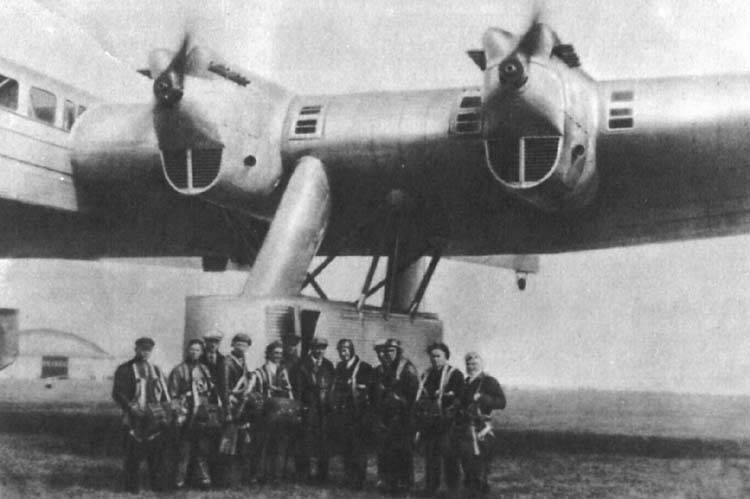
In subsequent flights, it turned out that, although the vertical shaking due to the new design of the plumage was gone, the horizontal one still remained. However, M. A. Snegirev, using his extensive experience as a tester, found a way to extinguish it by changing the operating modes of the engines.
Continued tests showed good flight qualities of the aircraft. The final test flight was scheduled for November 20, after which K-7 was to fly to Moscow. It was necessary to determine the maximum speed of the machine on the ground, on a dimensional basis. This tenth flight was a success, but because of the mistake of the experimenters on the ground, the measurements failed.
The deputies K. A. Kalinina, A. T. Rudenko and A. S. Balinsky, went to re-determine the velocity on a dimensional basis. The flight was scheduled for the day of rest - November 21. Before this, K-7 had already managed to fly over 5 hours in the air. After the take-off and climb of 1000 meters, the task involved flying to a measuring kilometer, over which it was necessary to drop, to a height of 100 meters and three times passing the calculated base with a maximum speed.
At two o'clock in the afternoon K-7 with 20 members of the test crew on board flew out to the measured kilometer. It is worth mentioning the memoirs of D. A. Chebyshev, one of the engineers who participated in the tests: “At the appointed time, K-7 flew over us, the pilot determined that we were ready for measurements, and took the plane to the zone where he picked up speed and went again to us. Having not reached us 3-4 km, suddenly the car suddenly went abruptly at an angle of 30-40 ° with maximum speed. A strike on the ground took down the chassis. The plane jumped and crashed into the ground with the engines running. A fire started".
And this is what one of the five crewmembers who survived the plane crash, P.I. Semerenko, recalled: “When entering the measured kilometer Snegiryov gave full gas. There was a vibration of tail farms. I counted blows 15-20. Suddenly, the sound of the engines' buzz was joined by the sound of a break in the lower side member of the left tail boom. Split ends of the side member clamped the elevator control, and K-7 could not get out of the decline. I note the vibration in my memory, measure the dive angle in my eye, repeat degrees out loud. On the ground, the car gives the left bank. Waiting for the end. The elevators are still motionless. Hit..."
Workers and engineers experienced the death of their offspring and 15 crew members. Kalinin due to heart disease for two months out of order.
But the disaster did not undermine the faith of the team in their strengths and abilities. To investigate the causes of the accident, several competent commissions were organized, in which the most prominent aviation specialists of the country participated. The findings suggested that the source of vibration was servo-steering in some modes of operation of the seventh engine. But this reason has not been documented. And only a few years later, M. V. Keldysh found a way out in the fight against flutter - a weight balance of the rudders is necessary. But then they did not know it yet ...
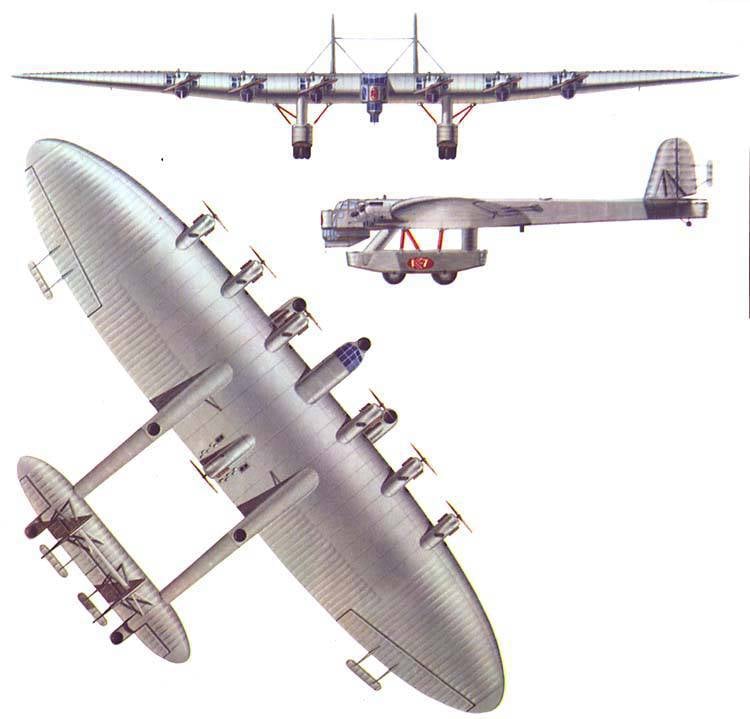
Having considered the conclusions of the specialists who did not find any errors in the calculations and the aircraft design, by the decision of the Chief of the Administration, Kalinin was instructed to urgently start building two new K-7 variants (passenger and military) with a timeline for their withdrawal at the beginning of 1935. And for their production KB K.A. Kalinina received a new production base - the Voronezh Aviation Plant.
The changed views of the leadership of domestic aviation on the construction of large aircraft did not allow the team to complete work on the K-7. The aircraft were mothballed, and one of them was half ready. And although Kalinin repeatedly tried to prove the necessity of a machine of this type, he failed to break the confrontation of his project.
The K-7 aircraft entered history world aviation as a bold move, since similar aircraft at that time did not exist in any country in the world. They appeared only in the course of the Second World War, showing how far-sighted was the plan of the outstanding Soviet aircraft designer Konstantin Alekseevich Kalinin and his associates.
Information